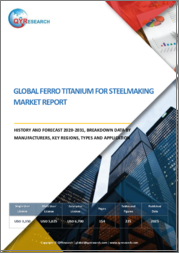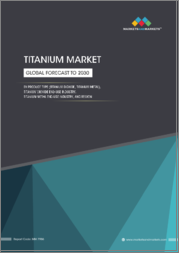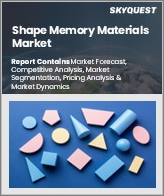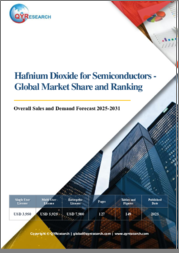
|
시장보고서
상품코드
1459359
세계의 고순도 티타늄 시장(2024-2031년)Global High Purity Titanium Market - 2024-2031 |
||||||
개요
세계의 고순도 티타늄(High Purity Titanium) 시장 규모는 2023년 9억 달러였으며, 2024-2031년의 예측 기간 동안 CAGR 3.7%로 추이하며 성장 할 것으로 예상되며, 2031년에는 12억 달러에 달할 것으로 예측되고 있습니다.
고순도 티타늄은 치과용 임플란트, 정형외과용 임플란트 및 수술용 장비와 같은 바이오메디컬 용도에 사용됩니다. 내 부식성, 생체 적합성 및 뼈 조직과의 융합 능력으로 인해 티타늄은 의료용 임플란트에 이상적인 재료입니다. 바이오메디컬 용도에서 고순도 티타늄의 사용은 고령화 사회와 의료기술의 향상이 의료와 치료의 필요성을 높이기 때문에 증가할 것으로 예상됩니다.
고순도 티타늄의 세계 수요는 신재생에너지에 대한 투자 증가에 의해 견인되고 있습니다. 티타늄은 가볍고 내구성이 강하고 부식에 강하기 때문에 태양전지판과 풍력 발전 터빈과 같은 재생 가능 에너지 시스템의 부품 생산에 필요한 재료입니다. 이러한 용도에 대한 고순도 티타늄의 필요성은 정부와 기업이 지속가능한 개발에 높은 우선순위를 두고 재생가능 에너지원으로 전환함에 따라 극적으로 증가할 것으로 예상됩니다.
유럽은 세계의 고순도 티타늄 시장의 1/3 이상을 차지하는 성장 지역 중 하나입니다. 유럽 기업의 부가 제조 기술의 이용은 독창적인 제품 설계에서 고순도 티타늄의 사용을 촉진합니다. 기업은 항공우주, 의료 및 자동차 용도에 맞춤형 티타늄 부품을 제조합니다. 유럽은 고순도 티타늄 기술 혁신의 주요 기지가 되어 이 분야에서 시장 확대를 더욱 촉진할 것입니다.
역학
항공우주 분야에서 고순도 티타늄 수요 증가
고순도 티타늄은 내열성, 내식성, 고강도 대 중량비를 포함한 뛰어난 품질로 큰 이익을 얻는 항공우주 산업으로 인해 높은 수요가 있습니다. 고순도 티타늄은 항공 여행 수요 증가와 친환경 항공기의 필요성으로 인해 항공우주 산업이 세계적으로 확대됨에 따라 수요가 증가할 것으로 예상됩니다.
예를 들어, 2021년 Boeing과 러시아의 주요 티타늄 제조업체인 VSMPO-AVISMA는 기존 및 미래의 Boeing 사 민간 항공기의 주요 티타늄 공급업체로서 VSMPO-AVISMA의 역할을 확인하는 각서를 체결했습니다. 이 각서는 Boeing사에게 신뢰할 수 있는 파트너로서의 지위를 강화하여 향후 수년간 지속적인 협력관계를 보장하게 됩니다. 이 책은 Boeing이 우리의 티타늄 제품의 우수성을 신뢰하고 탁월한 품질을 인정하고 있음을 보여줍니다.
임플란트 및 의료기기의 용도 확대
임플란트 및 기타 의료기기 제조에서 의료 산업에서 티타늄 사용 증가는 고순도 티타늄 세계 시장을 추진하는 중요한 요소입니다. 티타늄은 생체 적합성, 내구성, 내식성 때문에 치과 임플란트, 인공 관절, 척추 임플란트, 심장혈관 장비 등 다양한 의료용 임플란트에 이상적인 재료입니다.
예를 들어, 2021년 척추 시스템의 유명한 제조업체인 Ulrich Medical은 전략적 제휴를 통해 제공하는 제품의 범위를 크게 확대했습니다. 이 확장에는 독창적 인 척추 측만증 인대, 티타늄 요추 케이지, 경추 안정판 등 새로운 구성 요소가 포함됩니다. 또한 유명 제조업체와의 제휴로 척추측만증 치료를 보다 효과적으로 지원하는 최신 임플란트도 라인업에 합류했습니다.
높은 생산 비용
티타늄 광석의 채굴, 정제, 고순도 형태로의 가공에 걸리는 높은 제조 비용은 고순도 티타늄 시장의 큰 장벽이 되고 있습니다. 다른 원소와의 강한 반응성과 산소와의 친화성으로 인해 티타늄의 추출과 정화는 매우 어려운 것으로 알려져 있습니다. 따라서 크롤링법이나 최근의 밴 아켈 드 보어법과 같은 고급 처리법을 이용해야 합니다.
또한 인건비, 원재료비, 에너지비의 변동은 제조비용을 더욱 높여 제조업체가 시장에서 경쟁가격을 유지하기 어렵게 만듭니다. 2020년 7월 1일부터 Ishihara Sangyo Kaisha, ltd. 및 그 계열사는 아시아 태평양에서 티파케툼 산화티탄(TiO2)의 톤당 200달러의 가격 인상을 발표했습니다.
대용품·대체 재료
고순도 티타늄 시장은 대체 소재의 가용성과 대체 가능성에 의해 심각하게 제한되어 있습니다. 티타늄은 높은 중량 대비 강도, 부식에 대한 내성 등 뛰어난 특성을 가지고 있지만, 이전에 티타늄이 주요 소재였던 분야에서는 복합재, 강철 및 알루미늄과 같은 대체 소재가 더 자주 활용되고 있습니다.
또한, 제조자 및 최종 사용자는 재료 비용 절감, 보다 간단한 기계가공성, 대체 재료의 확립된 공급 경로 등 요인에 의해 대체 재료의 선택을 검토하도록 촉구될 수 있습니다. 또, 재료 과학 및 공학의 발전으로 티타늄과 동등하거나 더 우수한 품질의 신소재가 개발될 수 있으므로 경쟁이 심화되고 고순도 티타늄 시장의 확장을 저해할 수 있습니다.
목차
목차
제1장 조사 방법 및 범위
제2장 정의 및 개요
제3장 주요 요약
제4장 시장 역학
- 영향 요인
- 성장 촉진 요인
- 항공우주 분야에서 고순도 티타늄 수요 증가
- 임플란트와 의료기기에 대한 용도 확대
- 억제 요인
- 높은 제조 비용
- 대용품·대체 재료
- 기회
- 영향 분석
- 성장 촉진 요인
제5장 산업 분석
- Porter's Five Forces 분석
- 공급망 분석
- 가격 분석
- 규제 분석
- 러시아·우크라이나 전쟁의 영향 분석
- DMI의 견해
제6장 COVID-19 분석
제7장 제품별
- 99.95% 이하
- 99.95% 이상
제8장 제조 방법별
- 크롤링법
- 진공 아크 재용해
- 전자빔 냉간로 재용해
- 기타
제9장 용도별
- 항공우주 및 방위
- 자동차
- 화학처리
- 바이오메디컬
- 일렉트로믹스 및 반도체
- 석유화학
- 기타
제10장 지역별
- 북미
- 미국
- 캐나다
- 멕시코
- 유럽
- 독일
- 영국
- 프랑스
- 러시아
- 스페인
- 기타 유럽
- 남미
- 브라질
- 아르헨티나
- 기타 남미
- 아시아 태평양
- 중국
- 인도
- 일본
- 호주
- 기타 아시아 태평양
- 중동 및 아프리카
제11장 경쟁 구도
- 경쟁 시나리오
- 시장 포지셔닝/점유율 분석
- M&A 분석
제12장 기업 프로파일
- American Elements
- 기업 개요
- 제품 포트폴리오 및 설명
- 재무 개요
- 주요 개발 상황
- Toho Titanium Co., Ltd
- VSMPO-AVISMA Corporation
- OSAKA Titanium Technologies Co., Ltd.
- ATI Inc.
- ALB Materials Inc.
- ADMA Products, Inc.
- Honeywell
- Freund Corporation
- Alfa Full(Guangxi Tengxian) Titanium Dioxide Co., Ltd.
제13장 부록
LYJ 24.04.16Overview
Global High Purity Titanium Market reached US$ 0.9 Billion in 2023 and is expected to reach US$ 1.2 Billion by 2031, growing with a CAGR of 3.7% during the forecast period 2024-2031.
High-purity titanium is being used in biomedical applications such as dental implants orthopedic implants and surgical equipment. Because of its resistance to corrosion, biocompatibility and ability to fuse with bone tissue, titanium is a perfect material for medical implants. The usage of high pure titanium in biomedical applications is anticipated to increase due to the aging population and improvements in medical technology boosting the need for medical treatments and procedures.
The global demand for high-purity titanium is being driven by rising investments in renewable energy initiatives. Because titanium is lightweight, durable and resistant to corrosion, it is a necessary material for the production of parts for renewable energy systems like solar panels and wind energy turbines. The need for high-purity titanium in these applications is anticipated to increase dramatically as governments and businesses place a higher priority on sustainable development and make the shift to renewable energy sources.
Europe is among the growing regions in the global high purity titanium market covering more than 1/3rd of the market. The utilization of additive manufacturing techniques by European enterprises is propelling the usage of high-purity titanium in inventive product designs. The organizations are creating bespoke titanium components for aerospace, medicinal and automotive applications. Europe is set to become a major hub for high-purity titanium innovation, which will further propel market expansion in the area.
Dynamics
Growing Demand for High Purity Titanium in the Aerospace Sector
High purity titanium is in high demand because of the aerospace industry, which benefits greatly from its remarkable qualities, which include heat resilience, corrosion resistance and a high strength-to-weight ratio. High purity titanium is expected to become more in demand as the aerospace industry expands globally due to the increased demand for air travel and the need for more environmentally friendly aircraft.
For Instance, in 2021, Boeing and the leading Russian titanium producer VSMPO-AVISMA entered into a Memorandum of Understanding (MOU) confirming VSMPO-AVISMA's role as the primary titanium supplier for both existing and upcoming Boeing commercial aircraft. The agreement reinforces our status as a trusted partner to Boeing, ensuring our continued collaboration for years to come. The memorandum signifies Boeing's confidence in the excellence of our titanium products and acknowledges their outstanding quality.
Growing Uses for Implants and Medical Devices
The increasing use of titanium in the medical industry for the production of implants and other medical equipment is a key factor propelling the global market for high-purity titanium. Titanium is the perfect material for a variety of medical implants, such as dental implants, joint replacements, spinal implants and cardiovascular devices because of its biocompatibility, durability and resistance to corrosion.
For instance, in 2021, Ulrich Medical, a prominent maker of spinal systems, has considerably expanded the scope of its product offering through strategic alliances. The extension has new components including an inventive scoliosis ligament, titanium lumbar cages and cervical stability plates. Modern implants have been added to the company's portfolio as a result of its partnership with a well-known manufacturer to better assist scoliosis care.
High Production Costs
The high production costs involved in mining, purifying and processing titanium ores into high-purity forms are a major barrier to the market for high-purity titanium. Because of its strong reactivity with other elements and its affinity for oxygen, titanium is known to be extremely difficult to extract and cleanse. The makes it necessary to use sophisticated processing methods like the Kroll process or the more recent Van Arkel-de Boer procedure.
Furthermore, changes in the cost of labor, raw materials and energy can further increase manufacturing costs, making it difficult for manufacturers to maintain competitive pricing in the market. With effect from July 1, 2020, Ishihara Sangyo Kaisha, ltd. and its affiliates have announced a US$ 200 per metric ton price increase for tipaquetm titanium dioxide (TiO2) in the Asia-Pacific.
Replacement and Alternative Materials
The high-purity titanium market is severely limited by the availability of substitute materials and the possibility of substitution. Although titanium has great qualities, such as a high strength-to-weight ratio and resistance to corrosion, alternative materials, like composites, steel and aluminum, are being utilized more frequently in applications where titanium was formerly the predominant material.
Furthermore, Manufacturers and end-users may be encouraged to investigate substitute choices by factors including reduced material costs, simpler machinability and well-established supply channels for alternative materials. Furthermore, developments in material science and engineering might result in the creation of new materials with qualities that are on par with or even better than those of titanium, hence escalating rivalry and impeding the expansion of the high pure titanium market.
Segment Analysis
The global high purity titanium market is segmented based on product, production method, application and region.
Rising Demand for High-Purity Titanium in the Aerospace & Defense Industry
The Aerospace & Defense segment is among the growing regions in the global high purity titanium market covering more than 1/3rd of the market. High-purity titanium is anticipated to be in high demand as the aerospace industry continues to see rising demand for lightweight, fuel-efficient aircraft as well as improvements in military technologies needing materials able to survive extreme conditions.
Because titanium has special qualities that make it perfect for use in military and aerospace applications, these industries are important growth drivers in the globally market for high-purity titanium. Because of its outstanding strength-to-weight ratio, resistance to corrosion and ability to withstand high temperatures, titanium is a crucial material for the production of important parts such as landing gear, aircraft frames, engine components and armor plating for military vehicles.
Geographical Penetration
Growing Demand for High-Purity Titanium in Renewable Energy Infrastructure in Europe
Europe has been a dominant force in the global high purity titanium market. High-purity titanium is widely used in the European aerospace sector due to its superior durability and lightweight, which are crucial for producing parts for aircraft. European aerospace companies are investing in advanced titanium alloys due to a growing demand for fuel-efficient aircraft and increased air travel, which is driving the market's expansion.
The demand for high-purity titanium for renewable energy infrastructure is predicted to rise sharply as European nations shift to greener energy sources to satisfy sustainability targets, propelling market expansion. Furthermore, the European Union's goal of being carbon neutral by 2050 is probably going to spur more investment in renewable energy projects, which will support the growth of the high-purity titanium market.
For Instance, in 2023, INEOS Enterprises, based in London acquired Eramet Titanium & Iron (ETI) after regulatory approvals. The US$245 million deal is now in effect. ETI operates a facility in Norway for ilmenite transformation, producing titanium slag for the pigments industry, alongside high-purity pig iron sold to European foundries. The agreement also secures a long-term ilmenite supply from Grande Cote Operations, Eramet's subsidiary operating a mineral sands mine in Senega.
Furthermore, the European high-purity titanium market is seeing innovation due to technological breakthroughs in additive manufacturing. Additive manufacturing, commonly referred to as 3D printing, creates new opportunities in a variety of sectors by enhancing precision and efficiency in the creation of complex titanium components.
COVID-19 Impact Analysis
The global market for high pure titanium has experienced a variety of effects from the COVID-19 pandemic. Lockdowns and other limitations on movement initially created broad disruptions that resulted in a halt in production activity across a variety of industries, including aerospace, automotive and construction, which are major users of high-purity titanium.
Because of the resulting decline in demand for titanium products, inventories accumulated and prices began to decline. Further compounding market difficulties were supply chain delays, which made it more difficult to transfer raw materials and completed products, especially in areas severely impacted by the pandemic.
However, the demand for high-purity titanium began to rebound as the world economy gradually turned around and businesses started to operate again. The demand for titanium goods increased as a result of increased government stimulus packages meant to boost economies, as well as rising investments in infrastructure projects and the revival of air travel.
The pandemic also brought attention to the significance of titanium's special qualities, which include its strength, resistance to corrosion and lightweight design, which support the metal's ongoing usage in vital applications across a range of industries. As companies continue to adjust to the post-pandemic environment and give innovation and sustainability top priority in their operations, the market for high-purity titanium is anticipated to rise steadily in the coming years.
Russia-Ukraine War Impact Analysis
The global market for high-purity titanium may be significantly impacted by the conflict between Russia and Ukraine. The two biggest producers of titanium feedstock are Russia and Ukraine. Shortages of high-purity titanium raw materials might result from any disturbance in the supply chain brought on by geopolitical conflicts, such as trade restrictions, export prohibitions or logistical difficulties.
The may lead to higher costs and unpredictability in the supply chain for producers and consumers globally, especially in sectors where titanium is essential, such as aerospace, military and automotive. Moreover, investor confidence may be impacted by geopolitical instability in the area, which might cause volatility in the titanium markets. The unpredictability surrounding the supply of titanium feedstock from Russia and Ukraine may lead buyers to look into other suppliers or make investments to diversify their supply chains.
By Product
- 99.9 to 99.95%
- Above 99.95%
By Production Method
- Kroll Process
- Vacuum Arc Remelting
- Electron Beam Cold Hearth Remelting
- Others
By Application
- Aerospace & Defense
- Automotive
- Chemical Processing
- Biomedical
- Electronics & Semiconductor
- Petrochemical
- Others
By Region
- North America
- U.S.
- Canada
- Mexico
- Europe
- Germany
- UK
- France
- Italy
- Russia
- Rest of Europe
- South America
- Brazil
- Argentina
- Rest of South America
- Asia-Pacific
- China
- India
- Japan
- Australia
- Rest of Asia-Pacific
- Middle East and Africa
Key Developments
- On September 21, 2023, INEOS Enterprises, based in London acquired Eramet Titanium & Iron (ETI) after regulatory approvals. The US$245 million deal is now in effect. ETI operates a facility in Norway for ilmenite transformation, producing titanium slag for the pigments industry, alongside high-purity pig iron sold to European foundries. The agreement also secures a long-term ilmenite supply from Grande Cote Operations, Eramet's subsidiary operating a mineral sands mine in Senega.
- On January 04, 2021, The British Competition and Markets Authority has decided to launch a Phase 2 investigation into Tronox Holdings plc, a prominent integrated manufacturer of titanium dioxide pigment, regarding its proposed acquisition of the TiZir Titanium and Iron business from Eramet S.A. Before deciding whether to start a Phase 2 inquiry, the Company is expected to provide the CMA with remedies as part of the process. The Company will update the market on the transaction's progress.
Competitive Landscape
The major global players in the market include American Elements, Toho Titanium Co., Ltd, VSMPO-AVISMA Corporation, OSAKA Titanium Technologies Co., Ltd., ATI Inc., ALB Materials Inc., ADMA Products, Inc., Honeywell, Freund Corporation and Alfa Full (Guangxi Tengxian) Titanium Dioxide Co., Ltd.
Why Purchase the Report?
- To visualize the global high purity titanium market segmentation based on product, production method, application and region, as well as understand key commercial assets and players.
- Identify commercial opportunities by analyzing trends and co-development.
- Excel data sheet with numerous data points of high purity titanium market-level with all segments.
- PDF report consists of a comprehensive analysis after exhaustive qualitative interviews and an in-depth study.
- Product mapping available as Excel consisting of key products of all the major players.
The global high purity titanium market report would provide approximately 62 tables, 56 figures and 194 Pages.
Target Audience 2024
- Manufacturers/ Buyers
- Industry Investors/Investment Bankers
- Research Professionals
- Emerging Companies
Table of Contents
Table of Contents
1.Methodology and Scope
- 1.1.Research Methodology
- 1.2.Research Objective and Scope of the Report
2.Definition and Overview
3.Executive Summary
- 3.1.Snippet by Product
- 3.2.Snippet by Production Method
- 3.3.Snippet by Application
- 3.4.Snippet by Region
4.Dynamics
- 4.1.Impacting Factors
- 4.1.1.Drivers
- 4.1.1.1.Growing Demand for High Purity Titanium in the Aerospace Sector
- 4.1.1.2.Growing Uses for Implants and Medical Devices
- 4.1.2.Restraints
- 4.1.2.1.High Production Costs
- 4.1.2.2.Replacement and Alternative Materials
- 4.1.3.Opportunity
- 4.1.4.Impact Analysis
- 4.1.1.Drivers
5.Industry Analysis
- 5.1.Porter's Five Force Analysis
- 5.2.Supply Chain Analysis
- 5.3.Pricing Analysis
- 5.4.Regulatory Analysis
- 5.5.Russia-Ukraine War Impact Analysis
- 5.6.DMI Opinion
6.COVID-19 Analysis
- 6.1.Analysis of COVID-19
- 6.1.1.Scenario Before COVID
- 6.1.2.Scenario During COVID
- 6.1.3.Scenario Post COVID
- 6.2.Pricing Dynamics Amid COVID-19
- 6.3.Demand-Supply Spectrum
- 6.4.Government Initiatives Related to the Market During Pandemic
- 6.5.Manufacturers Strategic Initiatives
- 6.6.Conclusion
7.By Product
- 7.1.Introduction
- 7.1.1.Market Size Analysis and Y-o-Y Growth Analysis (%), By Product
- 7.1.2.Market Attractiveness Index, By Product
- 7.2.99.9 to 99.95%*
- 7.2.1.Introduction
- 7.2.2.Market Size Analysis and Y-o-Y Growth Analysis (%)
- 7.3.Above 99.95%
8.By Production Method
- 8.1.Introduction
- 8.1.1.Market Size Analysis and Y-o-Y Growth Analysis (%), By Production Method
- 8.1.2.Market Attractiveness Index, By Production Method
- 8.2.Kroll Process*
- 8.2.1.Introduction
- 8.2.2.Market Size Analysis and Y-o-Y Growth Analysis (%)
- 8.3.Vacuum Arc Remelting
- 8.4.Electron Beam Cold Hearth Remelting
- 8.5.Others
9.By Application
- 9.1.Introduction
- 9.1.1.Market Size Analysis and Y-o-Y Growth Analysis (%), By Application
- 9.1.2.Market Attractiveness Index, By Application
- 9.2.Aerospace & Defense*
- 9.2.1.Introduction
- 9.2.2.Market Size Analysis and Y-o-Y Growth Analysis (%)
- 9.3.Automotive
- 9.4.Chemical Processing
- 9.5.Biomedical
- 9.6.Electronics & Semiconductor
- 9.7.Petrochemical
- 9.8.Others
10.By Region
- 10.1.Introduction
- 10.1.1.Market Size Analysis and Y-o-Y Growth Analysis (%), By Region
- 10.1.2.Market Attractiveness Index, By Region
- 10.2.North America
- 10.2.1.Introduction
- 10.2.2.Key Region-Specific Dynamics
- 10.2.3.Market Size Analysis and Y-o-Y Growth Analysis (%), By Product
- 10.2.4.Market Size Analysis and Y-o-Y Growth Analysis (%), By Production Method
- 10.2.5.Market Size Analysis and Y-o-Y Growth Analysis (%), By Application
- 10.2.6.Market Size Analysis and Y-o-Y Growth Analysis (%), By Country
- 10.2.6.1.U.S.
- 10.2.6.2.Canada
- 10.2.6.3.Mexico
- 10.3.Europe
- 10.3.1.Introduction
- 10.3.2.Key Region-Specific Dynamics
- 10.3.3.Market Size Analysis and Y-o-Y Growth Analysis (%), By Product
- 10.3.4.Market Size Analysis and Y-o-Y Growth Analysis (%), By Production Method
- 10.3.5.Market Size Analysis and Y-o-Y Growth Analysis (%), By Application
- 10.3.6.Market Size Analysis and Y-o-Y Growth Analysis (%), By Country
- 10.3.6.1.Germany
- 10.3.6.2.UK
- 10.3.6.3.France
- 10.3.6.4.Russia
- 10.3.6.5.Spain
- 10.3.6.6.Rest of Europe
- 10.4.South America
- 10.4.1.Introduction
- 10.4.2.Key Region-Specific Dynamics
- 10.4.3.Market Size Analysis and Y-o-Y Growth Analysis (%), By Product
- 10.4.4.Market Size Analysis and Y-o-Y Growth Analysis (%), By Production Method
- 10.4.5.Market Size Analysis and Y-o-Y Growth Analysis (%), By Application
- 10.4.6.Market Size Analysis and Y-o-Y Growth Analysis (%), By Country
- 10.4.6.1.Brazil
- 10.4.6.2.Argentina
- 10.4.6.3.Rest of South America
- 10.5.Asia-Pacific
- 10.5.1.Introduction
- 10.5.2.Key Region-Specific Dynamics
- 10.5.3.Market Size Analysis and Y-o-Y Growth Analysis (%), By Product
- 10.5.4.Market Size Analysis and Y-o-Y Growth Analysis (%), By Production Method
- 10.5.5.Market Size Analysis and Y-o-Y Growth Analysis (%), By Application
- 10.5.6.Market Size Analysis and Y-o-Y Growth Analysis (%), By Country
- 10.5.6.1.China
- 10.5.6.2.India
- 10.5.6.3.Japan
- 10.5.6.4.Australia
- 10.5.6.5.Rest of Asia-Pacific
- 10.6.Middle East and Africa
- 10.6.1.Introduction
- 10.6.2.Key Region-Specific Dynamics
- 10.6.3.Market Size Analysis and Y-o-Y Growth Analysis (%), By Product
- 10.6.4.Market Size Analysis and Y-o-Y Growth Analysis (%), By Production Method
- 10.6.5.Market Size Analysis and Y-o-Y Growth Analysis (%), By Application
11.Competitive Landscape
- 11.1.Competitive Scenario
- 11.2.Market Positioning/Share Analysis
- 11.3.Mergers and Acquisitions Analysis
12.Company Profiles
- 12.1.American Elements*
- 12.1.1.Company Overview
- 12.1.2.Product Portfolio and Description
- 12.1.3.Financial Overview
- 12.1.4.Key Developments
- 12.2.Toho Titanium Co., Ltd
- 12.3.VSMPO-AVISMA Corporation
- 12.4.OSAKA Titanium Technologies Co., Ltd.
- 12.5.ATI Inc.
- 12.6.ALB Materials Inc.
- 12.7.ADMA Products, Inc.
- 12.8.Honeywell
- 12.9.Freund Corporation
- 12.10.Alfa Full (Guangxi Tengxian) Titanium Dioxide Co., Ltd.
LIST NOT EXHAUSTIVE
13.Appendix
- 13.1.About Us and Services
- 13.2.Contact Us



















